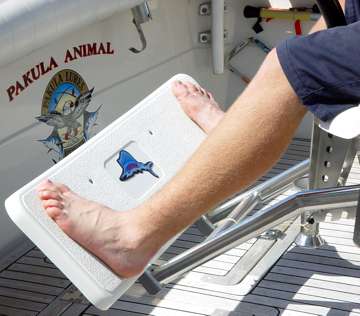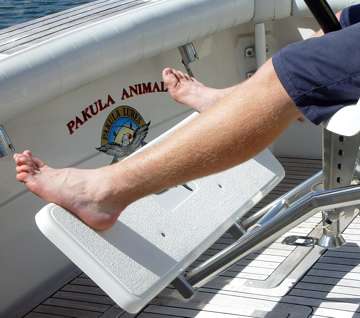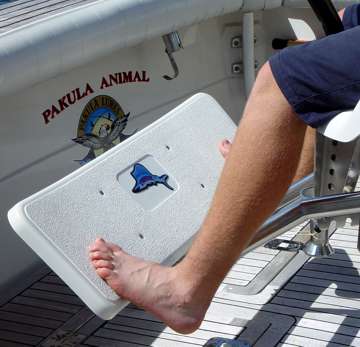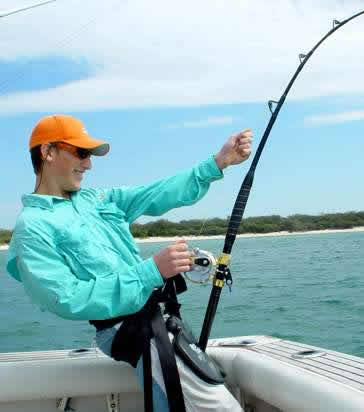09: Get the Rod Out
Between The Lines - Ch 08: Training
|
Some anglers make some techniques look very easy, such as getting the rod out of the holder and into position to fight a fish. You have probably guessed, it's not easy at all. It is one of those little things that should be explained and of course, practised. These are a simple set of quick explanations and exercises. When the rod is loaded with a fish screaming line off the reel there is considerable pressure locking the rod in the holder regardless of the rod's configuration. There is also considerable weight that will be felt instantly the rod is removed from the holder. The first exercise uses a stand-up outfit. The angler should wear at least a gimbal belt and for the exercise, a harness, both of which should have been previously adjusted to fit before the rod is taken out.
Facing the back of the boat, grab the rod high on the foregrip with the hand on the outward side of the boat. Pull back on the rod to unlock it from the holder, but not hard enough to jam it against the other side. With the other hand grab the rod under the reel and lift it up and out of the holder. Note that the rod will bow to the pressure, so as soon as the rod is on the way out, pull with the top hand and push with the lower to keep the rod upright, as you should try to keep the rod loaded and line tight throughout the fight. When hooked up the angler should get into a position that they are likely to remain during the initial stages of the fight. This spot should also be out of the way of the others who are pulling in the other gear. Up against the transom of the boat which has the advantage of being a great place for the angler to brace themselves against the pressure of the fish and the movement of the boat, is ideal. As they move from the rod holder to their fighting position the rod butt is placed in the gimbal, harness clipped up and the left hand is placed on the reel pushing it away with slight pressure to balance the outfit. The second exercise uses a Bent Butt Chair Rod. This exercise is similar to the previous one as it is getting the rod out of the holder and into fighting mode.
Facing the back of the boat, grab the rod high on the foregrip with the hand on the outward side of the boat. Pull back on the rod to unlock it from the holder, but not hard enough to jam it against the other side. With the other hand grab the rod under the reel and lift it up and out of the holder. Note that the rod will bow to the pressure so as soon as the rod is on the way out, pull with the top hand and push with the lower to keep the rod upright as you should try to keep the rod loaded and line tight throughout the fight. Note that there is significantly more weight on a heavy tackle bent butt outfit itself and a great deal more on a loaded rod than a stand-up outfit. The angler should be ready and brace themselves for this. Under the load an angler may wish to back the drag off to around 8kg to make getting the rod out of the holder and into the chair easier. Certainly, if the angler can keep the rod tip high and the drag on strike there is less chance of slack line and pulled hooks if the fish is of a reasonable size relative to the tackle. If the fish is relatively small, then back off the drag so that the fish can run against the drag pressure. Once the rod is out of the holder the angler moves to the chair and puts their foot which is on the centre side of the boat on the far side of the chair footrest. The rod butt is then placed in the gimbal, and the other foot lifted to the footrest. The rod is then pulled back to make clipping in the seat harness easier. Once this is accomplished the left hand is placed on the reel pushing it away with slight pressure to balance the outfit. When the angler is clipped up they can take advantage of the situation and run through pumping exercises. This exercise will be much easier if the angler has previously done the angler bungy and scale exercises. There are two distinct styles. The first and easiest is the "Pivot Style" as shown in the previous video clip. With an assistant putting a considerable load on the rod you will find as the angler leans forward they are lifted out of the chair when the angler leans back the rod is lifted. The chair may need to be adjusted to make this balance easier. The basic set up is the back of the knees should be level with the top of the chair seat with their feet flat on the footrest. Note that the feet should be spread apart as widely as possible to aid stability. The second is the ‘Traditional Slide' where the angler simply slides on the chair, relaxing the legs to come forward to wind line and pushing back to load the rod. With this style, the chair set up has the footrest higher and positioned so that when the legs are straight the back of the seat harness is level with the back of the chair. With this style, the angler can lock their legs straight to maximize pressure on the fish.
The angler can make fine adjustments by adjusting where they put their feet on the game chair footrest. Putting the feet in the middle of the footrest is the normal position and where the initial chair set-up is done. To make it harder for the rod to lift the angler out of the chair the feet are moved to the top of the footrest. Placing the feet at the bottom makes it easier for the rod to lift the angler. Note that the wider the angler can spread their feet on the footrest, the more balanced they will be in the chair.
If the angler gets the feeling of being overbalanced they can swing their right arm and shoulder back behind them to regain balance or grab onto the arm of the fighting chair with the right hand. The right hand is specified because the left hand should remain on the reel at all times, pushing slightly away. This is to minimize injury from the rod crashing into the angler if the line breaks on a loaded rod. Once the above exercises have been done on a stationary boat, try practising them on the water while slowly towing something such as a bag or small sea anchor (drogue) that will pull line off on the outfit's strike setting. You can have lots of fun doing this even though the difficulty of the exercise is soon realised and the value of going to this extra effort becomes apparent.
|









